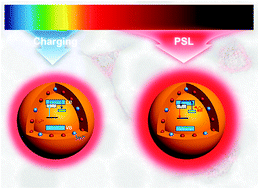Broadband NIR photostimulated luminescence nanoprobes based on CaS:Eu2+,Sm3+ nanocrystals†
Abstract
Near-infrared (NIR) photostimulated luminescence (PSL) nanocrystals (NCs) have recently evoked considerable interest in the field of biomedicine, but are currently limited by the controlled synthesis of efficient PSL NCs. Herein, we report for the first time the controlled synthesis of CaS:Eu2+,Sm3+ NIR PSL NCs through a high-temperature co-precipitation method. The role of Sm3+ co-doping and the effect of thermal annealing on the optical properties of the NCs as well as the charging and discharging processes, the trap depth distribution, and the underlying PSL mechanism are comprehensively surveyed by means of photoluminescence, persistent luminescence, thermoluminescence, and PSL spectroscopies. The as-prepared NCs exhibit intense PSL of Eu2+ at 650 nm with a fast response to stimulation in a broad NIR region from 800 nm to 1600 nm, a duration time longer than 2 h, and an extremely low power density threshold down to 10 mW cm−2 at 980 nm. Furthermore, by taking advantage of the intense NIR PSL, we demonstrate the application of CaS:Eu2+,Sm3+ NCs as sensitive luminescent nanoprobes for biotin receptor-targeted cancer cell imaging. These results reveal the great promise of CaS:Eu2+,Sm3+ nanoprobes for autofluorescence-free bioimaging, and also lay the foundation for future design of efficient NIR PSL nanoprobes towards versatile bioapplications.



 Please wait while we load your content...
Please wait while we load your content...